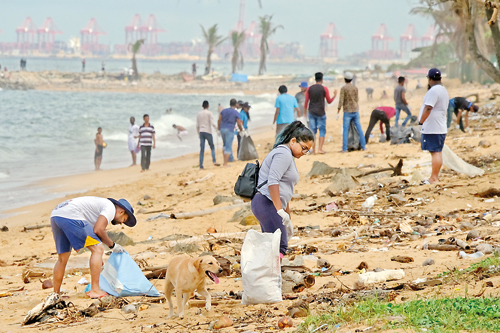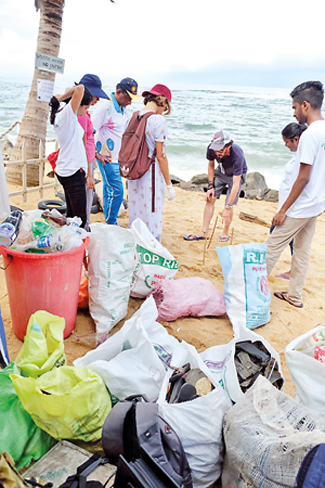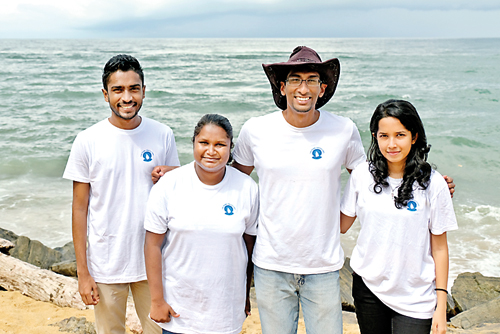A day on the beach, cleaning and upcycling

So much to do: Wellawatte beach before the clean-up. Pix by Amila Gamage
If you were taking a morning stroll on the Wellawatte Beach last Sunday, you may have spotted a group of people hard at work picking up the garbage strewn around. The Pearl Protectors as they call themselves along with volunteers from the Rotaract Club of ACBT and Flip Yarn were doing their bit for ‘World Cleanup Day’ – September 22.
Though primarily focused on cleaning the beach they also had an awareness workshop on upcycling and practical demonstrations on how to make eco bricks. They were shown sustainable products versus the more commonly used plastic products.
Muditha Katuwawala, coordinator of the Pearl Protectors said the event was all about celebrating World Cleanup Day as well as creating awareness. “We are trying to create an educational session here, we have brought eco friendly alternatives and we are showing what the pollutants are and what the alternatives are. Our purpose is when people go to the beach and clean up, we don’t just want them to clean and go home. We want them to inspire people, talk to others and inspire other young people to join in. And to be aware of the conservation that needs to happen.”

Lesson on upcycling: Hugo teaching volunteers how to make eco bricks
The Pearl Protectors’ main focus is marine protection. “Sri Lanka being an island we are surrounded by the ocean but many Sri Lankans don’t see the threats and the challenges faced to our ocean. The main threat we are facing is single use plastic along with the pollution that is being gushed out. All rivers, especially the Kelani river is gushing out a lot of garbage. If you take the seabed, 80 percent of it is covered in pollutants–plastic, plastic bags, you name it. You don’t normally see it but if you go scuba diving or snorkeling you will. Our organisation is trying to create awareness and come up with policies that the government could follow,” adds Muditha.
Hugo Kaempfer, the founder of FlipYarn, a company that takes discarded flip flops and turns them into sunglasses, spectacle cords and bracelets, conducted the mini workshop on Upcycling. “Upcycling tends to be more focused on products and materials that can’t necessarily be recycled, a great example being flip flops. The whole idea of upcycling is to create circularity therefore closing the loop on product and material life cycles. The traditional model of so-called linear manufacturing is where raw materials are taken to make a product which is then thrown away at the end of its life as waste. The idea of circularity, however, is to prevent this waste from ending up in a landfill by actually reusing the product or material again. The goal of this whole circular process is to ensure the impact on our planet is hopefully very little. The reason that upcycling really does help with our environmental efforts is that it stops the need for new and similar material from being manufactured.”

Showing the way: Muditha Katuwawala (third from left) and other Pearl Protectors
Collecting their trash into biodegradable bags and segregating it carefully, the Pearl Protectors took what happens to the waste after the clean-up very seriously. The PET bottles were used for upcycling, to make eco bricks and for a plastic bottle Christmas tree. The discarded rubber slippers collected were taken by FlipYarn for upcycling, and the glass and remaining plastic waste by Cleantech for recycling and reusing.


